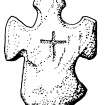Barra, Eoligarry, Cille-bharra
Cross Slab (Early Medieval), Rune Inscribed Stone (Norse)
Site Name Barra, Eoligarry, Cille-bharra
Classification Cross Slab (Early Medieval), Rune Inscribed Stone (Norse)
Alternative Name(s) Kilbharr Church; St Mary's Chapel; Cille Bharra; Kilbarr
Canmore ID 319368
Site Number NF70NW 3.04
NGR NF 7051 0738
Datum OSGB36 - NGR
Permalink http://canmore.org.uk/site/319368
- Council Western Isles
- Parish Barra
- Former Region Western Isles Islands Area
- Former District Western Isles
- Former County Inverness-shire
Field Visit (8 August 1924)
RUNIC STONE. The only rune-inscribed stone known in the Hebrides was found in the churchyard at Kilbar (Figs. 174, 177), but is now in the National Museum of Antiquities. It measures about 4 ½ feet in height by 12 to 16 inches broad, and ten inches thick, and bears on one face across of Celtic type, circled at the intersection of the arms and filled with a simple plait work, while the lower limb is flanked by a pair of double scrolls and fretwork. On the other side is the inscription in runes. This is obscure, and no satisfactory interpretation has been made. The runic letters which are clear seem to read:
UR THUR KIRTHU STI[N-]R
RISKURS S[] RISTR
[]
The broken end has meant the loss of some letters, particularly in the second and third lines. For a more definite reading see Proc. Soc. Ant. Scot., XV., pp. 33-6. This reading depends upon the acceptance of certain letters as being on the stone, which a close inspection fails to justify.
RCAHMS 1928, visited 8 August 1924.
Reference (2001)
(4) (NMS X.IB 102). Cross-slab of dark grey local garnet metapelite, broken obliquely at the head and flaked at the foot of face (a). It measures 1.36m in height and increases in width from 0.25m at the foot to a maximum of 0.39m below the head; the thickness varies from 45mm to 80mm. Face (a) is filled by a cross in low relief, incomplete at head and foot but over 0.85m in height and 0.38m across the arms. It is defined by a bead-moulding which encloses sunken circular armpits about 30mm in diameter, and the shaft tapers slightly downwards whereas the arms are straight-sided. The cross is filled with flat interlace, comprising a four-strand plait in the shaft and less regular interlace in the cross-head and arms. The sides of the shaft are flanked by continuous square key-pattern, linked to the uncarved area at the foot of the shaft, and then by simple S-scrolls below the cross-head. There are fragmentary remains of similar scrolls flanking the top arm.
Face (b) is filled with an inscription in Old Norse runes, incised in three lines which read down from the top of the slab. The letters in the first line are about 0.16m high, while those in the second line, which is enclosed by two irregular incised lines, vary from 65mm to 100mm. Only a few characters remain at the beginning of the third line, which is heavily worn. Although the surface on which the runes are cut appears to have been lightly dressed, many of them are damaged and the readings by Stephens and Olsen involve many doubtful assumptions. A reading has been made by Professor R I Page.(vi)
]*ir thur(:)kirthu:s(t)i*ar
]*r(.)is(:)kurs(:)s**.ristr
]*(.)**
This probably contains the female name Thorgerth and, less certainly, the male name Steinar, with a commemorative formula referring to the erection of the cross.
Although comparisons have been made with Manx cross-slabs,(vii) the form of the ring-less cross is closer to those on slabs at Govan, and the S-scrolls flanking it may be matched in Argyll, at Soroby and Kilbride. The inscription filling one face of the slab can be compared with Scandinavian examples rather than Manx ones.(viii) A date in the second half of the tenth century is probable.
(iv) RCAHMS 1928, No. 436 (a-d) and figs.146-8. These slabs are of 14th-15th century date.
I Fisher 2001














